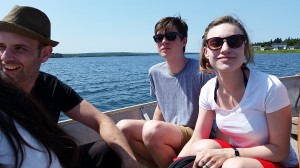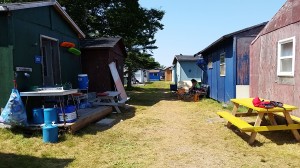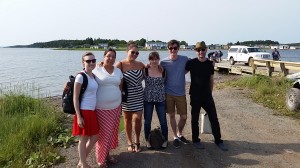Potlotek, also known as Chapel Island, is a Mi’gmaq community about an hour’s drive from Eskasoni. The menigu (‘island’) is located right on the Bras d’Or Lake, and is only accessible by a (short) boat ride. Our second day of travels brings us here, because around this time of year Potlotek is a central meeting place for people in the Mi’gmaq community; many families from Eskasoni go to Chapel Island for St. Anne’s Mission, and have been doing so for years.
The picture painted at Potlotek is encouraging, to say the least! Stepping foot on the island means seeing families gathered together outside of their cabins, mijua’ji’jg (‘children’) running around yelling to each other in Mi’gmaw. The atmosphere is friendly and welcoming—you can really feel a sense of community here.
We meet with Sherise Paul-Gould, Starr Paul, and Kattirin Johnson, all of whom have been teaching at various grade levels for many years in the Mi’gmaw Immersion Program at Eskasoni. Below are some memorable experiences shared with us:
1. Kattirin (Kat) Johnson is a grade 4 immersion transition teacher. Transition helps Mi’gmaq Immersion students that have been in the program since kindergarten move into English.
-
The year starts out in Mi’gmaq but eventually everything turns into English
- Teach Mi’gmaq grammar (graded more harshly than English); focus on topics like word order variability (English vs. Mi’gmaq) and past and future tenses (learning correct person endings)
- Teach various aspects of English grammar
- Initial observation: Mi’gmaq immersion students in grade 5 were reading at a much higher level than students that were not part of the immersion program
- Conducted a study with students in immersion which showed that students taught exclusively in Mi’gmaq from kindergarten to grade 3 perform better than those that are not in the immersion program. The immersion students not only excelled in Mi’gmaq, but were later excelling in English literacy (see previous bullet point).
- Their research also showed that the students had higher levels of self-esteem/confidence and were more likely to get involved in extracurricular activities.
- This link has a nice sum up of Starr and Sherise’s talk from FEL 2013. Look for “An Inquiry into Two Aboriginal Language Immersion Programs”
Throughout our meeting, Starr, Sherise, and Kat stressed the importance of having an immersion program. This was one of the most important, if not primary, way of preserving the language in Eskasoni. Starting an immersion program is a large and complicated milestone, but it is absolutely necessary to keep the language going. What do you say, Listuguj?




